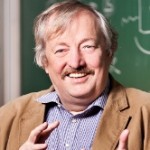Home › Forums › 2015 International Workshop on Quantum Foundations › Bohm’s theory › A problem of Bohmian mechanics
- This topic has 4 replies, 3 voices, and was last updated 8 years, 9 months ago by
Rainer Plaga.
-
AuthorPosts
-
July 6, 2015 at 1:34 pm #2499
Rainer Plaga
MemberThe problem that I have with Bohmian mechanics is that
it seems to be based on a concept (the effective system, discussed below)
that requires a postulate in addition to the ones
usually stated. Below I frame my problem as a question.
If I receive a comprehensible affirmative answer
the problem is resolved.The analysis of the quantum measurement problem
in both Bohmian mechanics (BM) and standard
QM (SQM), starts with assuming that there is
a “system to be measured”
which “has an effective wave function” (BM), or,
equivalently, “evolves unitarily” (SQM)”.
Let us call this system “effective system” (ES).
An ES and the Bohm equation determine the
motion of its point-like Bohm particles.It is a fact that ESs can exist
in some form. Therefore both standard QM
and BM have to be
able to derive their possible existence from
the postulates of the respective theory,
in other words, describe the pre-history
of the ES based only on their respective postulates.In SQM the possible existence of ESs
can be derived from its first three postulates
like this:SQM-DERIVATION
Its first postulate is the existence
of a system with a wavefunction.
That the system can be closed follows
from the third, the collapse postulate because
the system can be thus prepared
via measuring it. The second postulate
then guarantees that the system evolves
unitarily, i.e. has an effective wave function.The postulates of BM are (in short form):
1. There is a wave function of the universe
that evolves unitarily
2. There are Bohm particles that move
according to the Bohm equation.Can the possible
existence of ESs be derived from
postulates 1. and 2. in a manner
similar to the above SQM-Derivation?
If yes, how?Note that a “BM-derivation” based on the Bohmian analysis
of the measurement process
would be circular, i.e. nonsensical,
because the derivation of the measurement process
in BM already assumes the existence of ESs.
If there is no BM-derivation (none seems to be given
in the literature), I would conclude that presently
“ESs can be prepared.”
is a necessary additional postulate of BM.This is important because
in SQM the ES is a system that already collapsed.
The collapse postulate of SQM would thus implicitely
enter the postulates of BM.
It is not clear to me how its explicit introduction
could be avoided when one asks: what is a preparation in BM?July 8, 2015 at 4:34 pm #2532 Roderich TumulkaParticipant
Roderich TumulkaParticipantHi Rainer, here are three remarks on the problem you raised.
First, the situation is in a certain respect the same in Bohmian mechanics and in standard quantum mechanics. That is because if we consider the wave function of object and apparatus together (or of the whole solar system) then Bohmian mechanics and standard quantum mechanics both use the Schroedinger equation, so they use the same wave function.
Second, your question is ultimately one about the form of that wave function. Considering two systems, the x-system and the y-system (the environment of the x-system), for the x-system to be an “effective system,” i.e., to have an effective wave function, we need that Psi(x,y) is locally a product, i.e., Psi(x,y) = psi(x)phi(y) + Phi(x,y) where Phi has y-support macroscopically disjoint from the actual (Bohmian) Y. So the question is, why should the wave function of object and apparatus before a quantum experiment be of such local product form? Why should the object be initially unentangled with the apparatus? In fact, random wave functions of two systems typically have a high degree of entanglement. For example, if the x-system and the y-system are jointly in thermal equilibrium then they are highly entangled.
A relevant mechanism is the stretching of wave functions under the free evolution. It is known from scattering theory that the wave function of a single particle, when evolving freely (zero potential), becomes locally a plane wave. Let us apply this to, for example, a double-slit experiment, in which the electron used for the experiment gets “boiled off” from a piece of metal; initially, that electron is in thermal equilibrium with the metal, and thus highly entangled with other electrons in the metal. But once it leaves the metal, it propagates freely, so its wave function approaches a spherical shape, locally a plane wave. A collimation slit allows only the part of the wave propagating in the right direction to enter the double-slit setup. If the electron (the x-system) actually passes through the collimation slit, and gets used in the experiment, then the wave function Psi(x,y) of electron and apparatus is, in a neighborhood of (X,Y) in configuration space, a plane wave in the x-variable (and complicated in y). Since plane waves are not entangled (in the spinless case), Psi is locally a product psi(x)phi(y). (In the presence of spin, the spin of the electron in the double-slit setup may well be entangled with the spin of electrons in the metal piece, but that does not matter for the experiment.)
Third, the measurement rule can be formulated in Bohmian mechanics as follows: *IF* the object is initially unentangled with the apparatus *THEN* the probability distribution of the outcome is given by the standard formula. However, Bohmian mechanics is still meaningful, and still makes unambiguous predictions, in case the object *IS* initially entangled (or not perfectly unentangled) with the apparatus. The prediction is just whatever follows from the Schroedinger equation and Bohm’s equation of motion for object and apparatus together. For standard quantum mechanics, in contrast, this situation would be problematical because it is not covered by the standard axioms.
July 9, 2015 at 6:01 pm #2581Rainer Plaga
MemberHi Roderich,
Thanks for the comments!
Your characterization of my question at the
beginning of your second comment is excellent.
But you did not answer this question explicitly.
Are your comments meant as
an assertion that the answer to my question>Can the possible
>existence of ESs be derived from
>postulates 1. and 2. in a manner
>similar to the above SQM-Derivation?is “yes”?
And is your second comment meant to
supply such a derivation?!If yes, I do not comprehend why
the electron should get un-entangled
once it leaves the filament within BM.
Free evolution clearly will not do this trick, right?
In SQM the trick is that
the macroscopic filament (but not the electron
outside the filament) is effectively constantly
measured so that it rapidly collapses to an un-entangled
wave function.As to your third remark: I do realize that
BM will always make an unambiguous prediction,
even if the possibility to prepare ESs would not be
a priori assumed.
But how do you know that this prediction agrees
with experience? A proof that it always does
would seem to be equivalent to a derivation of
the postulate “ESs can be prepared”
from the axioms of BM.July 18, 2015 at 3:57 pm #2871 Reinhard WernerMember
Reinhard WernerMemberDear Rainer (if I may),
it is not completely clear to me what SQM is. In the operational account of the theory (let’s call that OQM) the only requirement on a preparation process is that the preparing system is dynamically decoupled from the ES and from whatever measuring device you plan to use. Entanglement between preparing system and ES is fine, in which case, of course, the prepared state would be mixed. That is not a conceptual issue. If the artful experimenter has achieved a pure state then, of course, the initial state was a product.
If you insist that every system (including your ES) ought to be in an ontologically interpreted pure state (some people, but not OQM, consider that part of SQM), then you would perhaps demand some particular choice of basis on the preparing system, and the outgoing pure states would be conditional on that. The prepared density matrix would thereby represented as a particular ensemble of pure states. But any choice of basis will do (This is one of the ways to discuss the statistics of a CHSH-type correlation experiment). In particular, each of the outgoing pure states of the ensemble will satisfy the Schrödinger equation for that subsystem (which makes sense, because we assumed dynamical decoupling).
Now in the Bohmian case you need more, as this theory rarely restricts to subsystems gracefully. In fact, they will probably sell this bug to you as a feature (the discovery of nonlocality) and say that anyhow the theory is not meant to work for any ES, but only for the whole Universe. If you want BM to hold effectively for the subsystem, you should take the “effective wave function” as described by Roderich. In an entangled situation the prepared system’s trajectory usually depends on the Y of the preparing device, and thus, for example on the dynamics of the preparing system, even long after, in SQM or OQM you have traced out the preparing system. That is, in BM you can usually not “trace out”. In particular, your conditional wave functions have no inclination to satisfy the Schrödinger equation of the ES. This is why you need an extra condition on the position space supports of the wave functions, as Roderich explained, which effectively puts you in a product situation, basically the only case where it works. There is no general physical reason I can see why that support condition should hold, and it is probably easy to come up with quite ordinary preparing processes where it does not.
Bohmians usually argue that it “obviously” holds when the selection criterion on the preparing device is macroscopic. I have no idea what they would say if what is selected on such a pointer criterion is still mixed. Maybe call in an exorcist. Or do some more hand waving and wishful thinking. Or denounce such cases as artificial. Maybe somebody will even answer here.
With best regards, Reinhard
July 22, 2015 at 2:57 pm #2948Rainer Plaga
MemberDear Reinhard,
with SQM I just meant OQM. I did not intend to claim that every
system to be measured is an ES, but just that the
standard BM discussion of quantum measurement starts
out with a system to be measured that is an ES.
My suspicion is that rather than exorcism 😉
they implicitly invoke OQM for the preparation procedure.
Indeed Duerr et al. justify their initial ansatz
for the discussion of the quantum measurement
theory in BM (arXiv:quant-ph/0308039v1, p.24)
with, quote, “according to orthodox quantum measurement theory”,
quoting inter alia von Neumann’s textbook.If my suspicion is correct rather than as an alternative to OQM,
BM is best understood as a complement to OQM that
demonstrates that OQM can be complemented
to be a deterministic theory.
Like u wrote in a previous guest post:
‘BM = OQM and P’
where P are Bohmian particles guided by the Bohmian equation.
Does this make sense?cheers rainer
-
AuthorPosts
- You must be logged in to reply to this topic.

Comments are closed, but trackbacks and pingbacks are open.